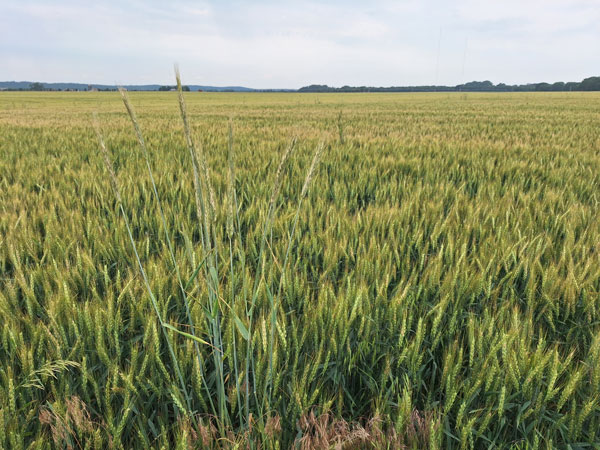Cereal rye can provide excellent weed suppression as a cover crop; however, it should be handled carefully. Cereal rye can be introduced into a wheat field (Figure 1) by contamination of harvest or seed conditioning equipment, dry fertilizer spreaders, or drills. Seeds and pollen can also be moved by wind or other natural means.
Cereal rye is very similar to wheat in terms of life cycle, growth requirements, and appearance. There are a few features that distinguish rye from wheat. First, cereal rye is generally taller than winter wheat, and the seed heads are usually longer and thinner. Other differences require a closer look. The ligule of cereal rye does not have a fringe of hairs (winter wheat does), and cereal rye does not have prominent auricles (winter wheat does). Cereal rye seeds are longer than wheat seeds and usually shaded more yellow or green rather than red.

Figure 1. Cereal rye growing in a wheat field. Photo by Sarah Lancaster, K-State Research and Extension.
Chemical control in wheat is limited to herbicide-tolerant varieties (discussed later in this article). Because there are few herbicide options in crops, preventing the introduction of cereal rye into wheat fields is critical. Cleaning equipment and planting weed-free seed are two important measures. Control during other phases of the crop rotation is also important. For example, letting rye emerge during a fallow phase of the rotation and applying glyphosate and/or atrazine. Hand rouging has long been used to remove cereal rye from wheat.
Herbicide-tolerant wheat varieties
Clearfield wheat varieties allow the use of Beyond (imazamox). Imazamox is more effective on other cool-season grass weeds, and only provides suppression of cereal rye. If you choose a Clearfield variety, be sure to spray before rye tillers and use a nitrogen fertilizer (up to 50% of the spray solution). Two applications (fall and spring) will provide better control than a single application.
CoAXium wheat varieties allow the use of Aggressor (quizalofop). Quizalofop provides excellent control of cereal rye. In studies at Great Bend control was 94% or greater with 10 or 12 fl oz of Aggressor applied with either NIS or MSO in fall or spring. Quizalofop is a Group 1 herbicide that only controls grasses.
In both systems, cereal rye control will be reduced if applications are made when temperatures are below 40F during the week following application.
Sarah Lancaster, Extension Weed Science Specialist
slancaster@ksu.edu
Tags: wheat weed control cereal rye